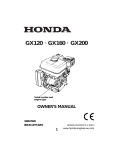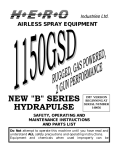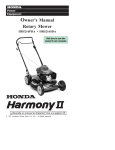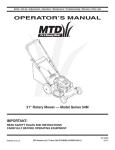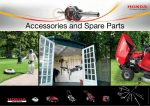Download Homelite UT902211 Portable Generator User Manual
Transcript
GCV135·GCV160 SERIAL NUMBER AND ENGINE TYPE OWNER’S MANUAL Honda Motor Co., Ltd. 2001 1 Thank you for purchasing a Honda engine. This manual covers the operation and maintenance of your engine: GCV135·GCV160 All information in this publication is based on the latest product information available at the time of printing. Honda Motor Co., Ltd. reserves the right to make changes at any time without notice and without incurring any obligation. No part of this publication may be reproduced without written permission. This manual should be considered a permanent part of the engine and should remain with it if it is resold. Pay special attention to statements preceded by the following words: Indicates a strong possibility of severe personal injury or death if instructions are not followed. Indicates a possibility of personal injury or equipment damage if instructions are not followed. Indicates that equipment or property damage can result if instructions are not followed. Gives helpful information. If a problem should arise, or if you have any questions about your engine, consult an authorized Honda dealer. The Honda engine is designed to give safe and dependable service if operated according to instructions. Read and understand the Owner’s Manual before operating the engine. Failure to do so could result in personal injury or equipment damage. 2 SAFETY INSTRUCTIONS To ensure safe operation− Honda engine is designed to give safe and dependable service if operated according to instructions. Read and understand the Owner’s Manual before operating the engine. Failure to do so could result in personal injury or equipment damage. Always make a pre-operation inspection (page 6 ) before you start the engine. You may prevent an accident or equipment damage. To prevent fire hazards and to provide adequate ventilation, keep the engine at least 1 meter (3 feet) away from buildings and other equipment during operation. Do not place flammable objects close to the engine. Children and pets must be kept away from the area of operation due to a possibility of burns from hot engine components or injury from any equipment the engine may be used to operate. Know how to stop the engine quickly, and understand the operation of all controls. Never permit anyone to operate the engine without proper instructions. Do not place flammable objects such as gasoline, matches, etc., close to the engine while it is running. Refuel in a well-ventilated area with the engine stopped. Gasoline is highly flammable and explosive under certain conditions. Do not overfill the fuel tank. There should be no fuel in the filler neck. Make sure that the filler cap is closed securely. 3 Safety Instruction To ensure safe operation− If any fuel is spilled, clean it up completely and allow petroleum vapours to dissipate before starting the engine. Do not smoke or allow flames or sparks where the engine is refueled or where gasoline is stored. Exhaust gas contains poisonous carbon monoxide. Avoid inhalation of exhaust gases. Never run the engine in a closed garage or confined area. Place the engine on a stable surface. Do not tilt the engine more than 15° from horizontal. Operating at excessive angles may result in fuel spillage. Do not place anything on the engine, as it may create a fire hazard. A spark arrester is available as an optional part for this engine. It is illegal in some areas to operate an engine without a spark arrester. Check local laws and regulations before operating. The muffler becomes very hot during operation and remains hot for a while after stopping the engine. Be careful not to touch the muffler while it is hot. To avoid severe burns or fire hazards, let the engine cool before transporting it or storing it indoors. SAFETY INDICATION LOCATION This indication warns you of potential hazards that can cause serious injury. Read it carefully. READ OWNER’S MANUAL BEFORE OPERATION. 4 COMPONENT IDENTIFICATION STARTER GRIP RECOIL STARTER OIL FILLER CAP SPARK PLUG MUFFLER FLYWHEEL BRAKE LEVER (applicable types) FUEL TANK CAP CONTROL LEVER AIR CLEANER FUEL VALVE FUEL TANK 5 PRE-OPERATION CHECK 1. Engine oil level Running the engine with insufficient oil can cause serious engine damage. Be sure to check the engine on a level surface with the engine stopped. 1. Remove the oil filler cap and wipe the dipstick clean. 2. Insert the dipstick into the oil filler neck, but do not screw it in. 3. If the level is low, add the recommended oil to the upper limit on the dipstick. SAE Viscosity Grades Use Honda 4-stroke, or an equivalent high detergent, premium quality mo- SAE tor oil certified to meet or exceed U.S. automobile manufacturer’s requirements for service classification SG, SH. Motor oils classified SG, SH will show TEMP this designation on the container. SAE 10W-30 is recommended for genAMBIENT TEMPERATURE eral, all temperature use. If single viscosity oil is used, select the appropriate viscosity for the average temperature in your area. Using nondetergent oil or 2-stroke engine oil could shorten the engine’s service life. OIL FILLER CAP/ DIPSTICK UPPER LIMIT LOWER LIMIT 6 2. Air cleaner Never run the engine without the air cleaner. Rapid engine wear will result. Remove the air cleaner cover and check the cleaner for dirt or obstruction of the element (page 19 ). ELEMENT AIR CLEANER COVER 7 3. Fuel Use automotive gasoline (Unleaded or lowleaded is preferred to minimize combustion chamber deposits). FOR NEW SOUTH WALES ONLY: Use unleaded fuel only. Never use an oil/gasoline mixture or dirty gasoline. Avoid getting dirt, dust or water in the fuel tank. Gasoline is extremely flammable and is explosive under certain conditions. Refuel in a well-ventilated area with the engine stopped. Do not smoke or allow flames or sparks in the area where the engine is refueled or where gasoline is stored. Do not overfill the fuel tank (there should be no fuel in the filler neck). After refueling, make sure the tank cap is closed properly and securely. Be careful not to spill fuel when refueling. Spilled fuel or fuel vapor may ignite. If any fuel is spilled, make sure the area is dry before starting the engine. Avoid repeated or prolonged contact with skin or breathing of vapor. KEEP OUT OF REACH OF CHILDREN. Fuel tank capacity: GCV135: 0.9 (0.24 US gal , 0.20 Imp gal) GCV160: 1.1 (0.29 US gal , 0.24 Imp gal) UPPER LEVEL FUEL FILLER NECK 8 GASOLINES CONTAINING ALCOHOL If you decide to use a gasoline containing alcohol (gasohol), be sure it’s octane rating is at least as high as that recommended by Honda. There are two types of ‘‘gasohol’’: one containing ethanol, and the other containing methanol. Do not use gasohol that contains more than 10% ethanol. Do not use gasoline containing methanol (methyl or wood alcohol) that does not also contain cosolvents and corrosion inhibitors for methanol. Never use gasoline containing more than 5% methanol, even if it has cosolvents and corrosion inhibitors. Fuel system damage or engine performance problems resulting from the use of fuels that contain alcohol is not covered under the warranty. Honda cannot endorse the use of fuels containing methanol since evidence of their suitability is as yet incomplete. Before buying fuel from an unfamiliar station, try to find out if the fuel contains alcohol, if it does, confirm the type and percentage of alcohol used. If you notice any undesirable operating symptoms while using a gasoline that contains alcohol, or one that you think contains alcohol, switch to a gasoline that you know does not contain alcohol. 9 STARTING THE ENGINE 1. Turn the fuel valve to the ON position. ON FUEL VALVE 2. Move the control lever to the CHOKE position. Do not use the choke if the engine is warm or the air temperature is high. CHOKE CONTROL LEVER 10 3. With FLYWHEEL BRAKE LEVER type only: Move the flywheel brake lever to the RELEASED position. The engine switch, which is linked with the flywheel brake lever, is turned on when the flywheel brake lever is moved to the RELEASED position. FLYWHEEL BRAKE LEVER RELEASED 4. Pull the starter grip lightly until resistance is felt, then pull briskly. Do not allow the starter grip to snap back against the engine. Return it gently to prevent damage to the starter. 11 5. When engine warms up, move the control lever to FAST or SLOW. SLOW FAST CONTROL LEVER 12 High altitude operation At high altitude, the standard carburetor air-fuel mixture will be excessively rich. Performance will decrease, and fuel consumption will increase. High altitude performance can be improved by installing a smaller diameter main fuel jet in the carburetor and readjusting the pilot screw. If you always operate the engine at altitudes higher than 1,830 m (6,000 feet) above sea level, have your authorized Honda dealer perform these carburetor modifications. Even with suitable carburetor jetting, engine horsepower will decrease approximately 3.5% for each 305 m (1,000 feet) increase in altitude. The affect of altitude on horsepower will be greater than this if no carburetor modification is made. Operation of the engine at an altitude lower than the carburetor is jetted for may result in reduced performance, overheating, and serious engine damage caused by an excessively lean air/fuel mixture. 13 STOPPING THE ENGINE 1. Move the control lever to the SLOW position. SLOW CONTROL LEVER 2. With FLYWHEEL BRAKE LEVER type: Return the flywheel brake lever to the ENGAGED position. The engine switch, which is linked with the flywheel brake lever, is turned off when the flywheel brake lever is moved to the ENGAGED position. FLYWHEEL BRAKE LEVER ENGAGED 14 3. Without FLYWHEEL BRAKE LEVER type: Move the control lever to the STOP position. The engine switch, which is linked with the control lever, is turned off when the control lever is moved to the STOP position. STOP CONTROL LEVER 4. Turn the fuel valve to the OFF position. OFF FUEL VALVE 15 MAINTENANCE Shut off the engine before performing any maintenance. To prevent accidental start-up, disconnect the spark plug cap. The engine should be serviced by an authorized Honda dealer unless the owner has proper tools and service data and feels he is mechanically qualified. Use only genuine Honda parts or their equivalent. The use of replacement parts which are not of equivalent quality may damage the engine. Periodic inspection and adjustment of the Honda engine is essential if high level performance is to be maintained. Regular maintenance will also ensure a long service life. The required service intervals and the kind of maintenance to be performed are described on the following table. 16 Maintenance Schedule REGULAR SERVICE PERIOD (4) ITEM Perform at every indicated month or operating hours interval, whichever comes first. Engine oil Check Change Air cleaner Check Clean Replace Flywheel brake pad Check (applicable types) Spark plug Check-Adjust Replace Spark arrester Clean (optional part) Idle speed Check-Adjust Fuel tank and filter Clean Valve clearance Check-Adjust Combustion chamber Clean Fuel tube Check Each First Every Every Every Every Every 6 3 year 150 hrs. 2 years use month or or or months months or 5 hrs. or 100 hrs. 250 hrs. 25 hrs. 50 hrs. ○ ○ ○ (2) ○ ○ (1) ○ ○ ○ ○ ○ ○ (3) ○ ○ (3) ○ (3) Every 2 years (Replace if necessary) (3) (1): Service more frequently when used in dusty areas. (2): Change engine oil every 25 hours when used under heavy load or in high ambient temperature. (3): These items should be serviced by an authorized Honda dealer, unless the owner has the proper tools and is mechanically proficient. See the Honda Shop Manual. (4): For commercial use, log hours of operation to determine proper maintenance intervals. 17 1. Oil change Drain the oil while the engine is still warm to assure rapid and complete draining. 1. Turn the fuel valve to the OFF position (see page 15 ). 2. Remove the oil filler cap and drain the oil into the oil container by inclining the engine toward the oil filler neck. 3. Refill with the recommended oil and check the oil level (see page 6 ). 4. Install the oil filler cap. ENGINE OIL CAPACITY: 0.55 (0.58 US qt , 0.48 Imp qt) OIL FILLER NECK Wash your hands with soap and water after handling used oil. Please dispose of used motor oil in a manner that is compatible with the environment. We suggest you take it in a sealed container to your local service station for reclamation. Do not throw it in the trash, pour it on the ground, or down a drain. 18 2. Air cleaner service A dirty air cleaner will restrict air flow to the carburetor. To prevent carburetor malfunction, service the air cleaner regularly. Service more frequently when operating the engine in extremely dusty areas. Never use gasoline or low flash point solvents for cleaning the air cleaner element. A fire or explosion could result. Never run the engine without the air cleaner. Rapid engine wear will result. 1. Remove the air cleaner cover by unhooking the two upper tabs on the top of the air cleaner cover and the two lower tabs. ELEMENT AIR CLEANER COVER UPPER TABS LOWER TABS 2. Remove the element. Carefully check the element for holes or tears and replace if damaged. 19 3. Tap the element lightly several times on a hard surface to remove excess dirt, or blow compressed air through the filter from the inside out. Never try to brush the dirt off; brushing will force dirt into the fibers. Replace the element if it is excessively dirty. 4. Install the element and air cleaner cover. ELEMENT 20 3. Flywheel brake inspection (applicable types) 1. Remove the recoil starter by removing the three 6 mm nuts. 2. Remove the fuel tank taking care not to disconnect the fuel tube from the fuel tank and fuel valve, and keeping the fuel tank to a level. 6 mm NUTS RECOIL STARTER FUEL TANK FUEL TUBE 3. Check the brake shoe thickness. If it is less than 3 mm (0.12 in), replace it with new one. BRAKE SHOE THICKNESS BRAKE SHOE 4. Install the fuel tank and recoil starter, and tighten the three 6 mm nuts securely. 21 4. Spark plug service Recommended spark plug: BPR6ES (NGK) Never use a spark plug of incorrect heat range. To ensure proper engine operation, the spark plug must be properly gapped and free of deposits. 1. Remove the spark plug cap and use a spark plug wrench to remove each spark plug. If the engine has been running, the muffler will be very hot. Be careful not to touch the muffler. 22 2. Visually inspect the spark plug. Discard the spark plug if there is apparent wear, or if the insulator is cracked or chipped. Clean the spark plug with a wire brush if it is to be reused. 3. Measure the plug gap with a feeler gauge. Correct as necessary by bending the side electrode. The gap should be: 0.70−0.80 mm (0.028−0.031 in) 0.70−0.80 mm (0.028−0.031 in) 23 4. Check that the spark plug washer is in good condition and thread the spark plug in by hand to prevent cross-threading. 5. After the spark plug is seated, tighten with a spark plug wrench to compress the washer. When installing a new spark plug, tighten 1/2 turn after the spark plug seats to compress the washer. When reinstalling a used spark plug, tighten 1/8−1/4 turn after the spark plug seats to compress the washer. The spark plug must be securely tightened. An improperly tightened spark plug can become very hot and may damage the engine. 24 5. Spark arrester maintenance (optional part) If the engine has been running, the muffler will be very hot. Allow it to cool before proceeding. The spark arrester must be serviced every 100 hours to maintain its efficiency. 1. Remove the muffler protector by removing the three 6 mm bolts. 2. Remove the spark arrester from the muffler by removing the two screws. (Taking care not to damage the wire mesh.) Check for carbon deposits around the exhaust port and the spark arrester, and clean if necessary. SCREW SPARK ARRESTER MUFFLER SCREW MUFFLER PROTECTOR 6 mm BOLTS 25 3. Use a brush to remove carbon deposits from the spark arrester screen. Be careful not to damage the spark arrester screen. SCREEN The spark arrester must be free of breaks and holes. Replace, if necessary. 4. Install the spark arrester and the muffler in the reverse order of disassembly. 26 TRANSPORTING/STORAGE When transporting the engine, turn the fuel valve OFF and keep the engine level to prevent fuel spillage. Fuel vapor or spilled fuel may ignite. Before storing the unit for an extended period; 1. Be sure the storage area is free of excessive humidity and dust. 2. Drain the fuel tank and carburetor into a suitable gasoline container: A.Turn the fuel valve to the OFF position. B. Remove the carburetor drain bolt and drain the carburetor. C. Turn the fuel valve to the ON position and drain the fuel in the fuel tank into the container. D.Retighten the carburetor drain bolt so that the float chamber and washer cannot be warped, and turn the fuel valve to the OFF position. OFF ON FUEL VALVE DRAIN BOLT Gasoline is extremely flammable and is explosive under certain conditions. Do not smoke or allow flames or sparks in the area. 27 3. Change the engine oil (page 18 ). 4. Pull the starter rope slowly until resistance is felt. This closes the valves, and protects them from dust and corrosion. 5. Coat areas that may rust with a light film of oil. Cover the engine and store it on a level surface in a dry, dust free area. 28 TROUBLESHOOTING When the engine will not start: 1. Is the fuel valve ON? 2. Is there fuel in the fuel tank? 3. Is gasoline reaching the carburetor? To check, loosen the drain bolt with the fuel valve ON. If any fuel is spilled, make sure the area is dry before testing the spark plug or starting the engine. Fuel vapor or spilled fuel may ignite. OFF ON DRAIN BOLT FUEL VALVE 29 4. Is the control lever positioned properly (page 10 )? 5. Is the flywheel brake lever positioned to the RELEASED position (page 11 )? (applicable types) 6. Is there a spark at the spark plug? a. Remove the spark plug cap. Clean any dirt from around the spark plug base, then remove the spark plug. b. Install the spark plug in the plug cap. c. Grounding the side electrode to any engine ground, pull the recoil starter to see if sparks jump across the gap. d. If there is no spark, replace the plug. If OK, reinstall the spark plug and try to start the engine again according to the isntructions. 7. If the engine still does not start, take the engine to an authorized Honda dealer. 30 SPECIFICATIONS Dimensions Power equipment description code Length Width Height Dry weight Engine Engine type Displacement Bore x Stroke Max. output Max. torque Fuel consumption Cooling system Ignition system PTO shaft rotation Fuel tank capacity Engine oil capacity Engine oil Spark plug GCV135 GJAF 351 mm (13.8 in) 331 mm (13.0 in) 353 mm (13.9 in) 9.5 kg (20.9 lbs) 4-stroke, overhead cam, 1 cylinder 135 cm (8.2 cu-in) 64 x 42 mm (2.5 x 1.7 in) 3.3 kW (4.5 PS)/3,600 rpm) 9.7 N·m (0.99 kgf-m)/2,500 rpm 313 g/kWh (230 g/PSh) Forced air Transistor magneto Counterclockwise 0.9 (0.24 US gal , 0.20 Imp gal) 0.55 (0.58 US qt , 0.48 Imp qt) Service classification SG or SH; SAE 10W-30 BPR6ES (NGK) Specifications may vary according to the types, and are subject to change without notice. 31 GCV160 GJAE Dimensions Power equipment description code Length Width Height Dry weight Engine Engine type Displacement Bore x Stroke Max. output Max. torque Fuel consumption Cooling system Ignition system PTO shaft rotation Fuel tank capacity Engine oil capacity Engine oil Spark plug 367 mm (14.4 in) 331 mm (13.0 in) 360 mm (14.2 in) 9.8 kg (21.6 lbs) 4-stroke, overhead cam, 1 cylinder 160 cm (9.8 cu-in) 64 x 50 mm (2.5 x 2.0 in) 4.1 kW (5.5 PS)/3,600 rpm 11.4 N·m (1.16 kgf-m)/2,500 rpm 313 g/kWh (230 g/PSh) Forced air Transistor magneto Counterclockwise 1.1 (0.29 US gal , 0.24 Imp gal) 0.55 (0.58 US qt , 0.48 Imp qt) Service classification SG or SH; SAE 10W-30 BPR6ES (NGK) Specifications may vary according to the types, and are subject to change without notice. 32


































